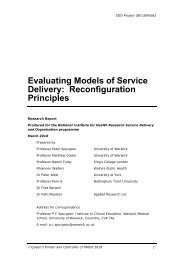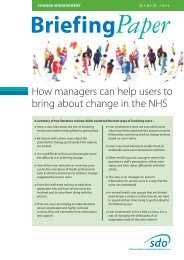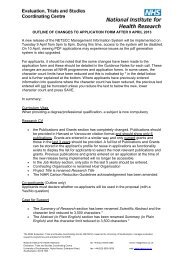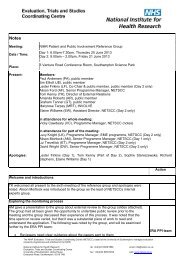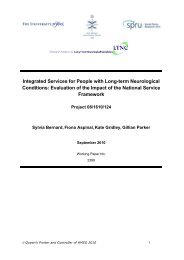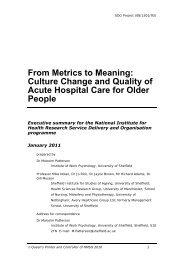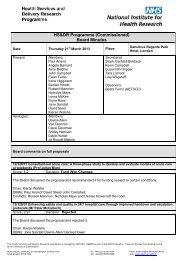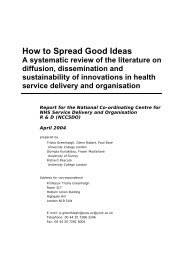Evaluation of IT modernisation in the NHS - NETSCC
Evaluation of IT modernisation in the NHS - NETSCC
Evaluation of IT modernisation in the NHS - NETSCC
Create successful ePaper yourself
Turn your PDF publications into a flip-book with our unique Google optimized e-Paper software.
Report to SDO for NCRS ProjectExecutive Summary(c) The timetable for implementation was unrealistic, caus<strong>in</strong>g uncerta<strong>in</strong>ty. Renew<strong>in</strong>gPatient Adm<strong>in</strong>istration Systems (PAS) was a bottleneck and this rate-limit<strong>in</strong>g stepcould not be reconciled with targets for implement<strong>in</strong>g substantive <strong>IT</strong> applications.(d) Short term benefits <strong>of</strong> <strong>IT</strong> <strong>modernisation</strong> are unlikely to be sufficient to persuade<strong>NHS</strong> staff to support <strong>the</strong> programme unreservedly.These <strong>in</strong>terviews were too early to assess <strong>the</strong> success <strong>of</strong> <strong>the</strong> NPf<strong>IT</strong> but demonstratedconcern among <strong>in</strong>terviews about <strong>the</strong> process <strong>of</strong> implementation.In stage B, senior managers and cl<strong>in</strong>icians felt that <strong>the</strong> NPf<strong>IT</strong> is a highly desirableobjective. Interviewees were enthusiastic about, and supportive <strong>of</strong>, <strong>the</strong> goals <strong>of</strong> <strong>the</strong>NPf<strong>IT</strong> but still had serious concerns, several <strong>of</strong> which were <strong>the</strong> same as before.Cont<strong>in</strong>u<strong>in</strong>g uncerta<strong>in</strong>ty was mak<strong>in</strong>g key managerial decisions about <strong>IT</strong>implementation more difficult, given <strong>the</strong> current need to make f<strong>in</strong>ancial sav<strong>in</strong>gs andachieve efficiencies. Although <strong>IT</strong> <strong>modernisation</strong> should facilitate <strong>the</strong>se goals <strong>in</strong> <strong>the</strong>longer-term, senior managers still did not know: (a) what <strong>the</strong> local costs <strong>of</strong>implementation will be; (b) when a replacement patient adm<strong>in</strong>istration systemcompliant with <strong>the</strong> programme will be available; (c) <strong>the</strong> timetable for delivery <strong>of</strong><strong>in</strong>terim applications; (d) <strong>the</strong> features <strong>of</strong> <strong>the</strong>se applications; (e) <strong>the</strong> likely benefits andefficiencies from new systems.These uncerta<strong>in</strong>ties made it difficult to prioritise local implementation <strong>of</strong> <strong>the</strong> NPf<strong>IT</strong>.Concern was expressed about threats to patient safety from a ‘patch and mend’approach to ma<strong>in</strong>ta<strong>in</strong> exist<strong>in</strong>g systems. Trust managers wanted concrete <strong>in</strong>formationabout implementation timetables, system compatibility with <strong>the</strong> long term goals <strong>of</strong> <strong>the</strong>programme, value-for-money and better communication with Connect<strong>in</strong>g for Health.4.2 Qualitative f<strong>in</strong>d<strong>in</strong>gs: level 2 – Process and impact <strong>of</strong> implementation <strong>of</strong>PACs and CPOEWe found four factors which <strong>in</strong>fluenced <strong>the</strong> adoption <strong>of</strong> CPOE and PACS:(a) The attributes <strong>of</strong> <strong>the</strong> application; <strong>the</strong> speed, ease <strong>of</strong> use, reliability and flexibility <strong>of</strong><strong>the</strong> application were key issues.(b) The characteristics <strong>of</strong> <strong>the</strong> adopter; <strong>the</strong>se were most important early dur<strong>in</strong>gimplementation and persuad<strong>in</strong>g users who were unfamiliar with <strong>IT</strong> was a challenge.




